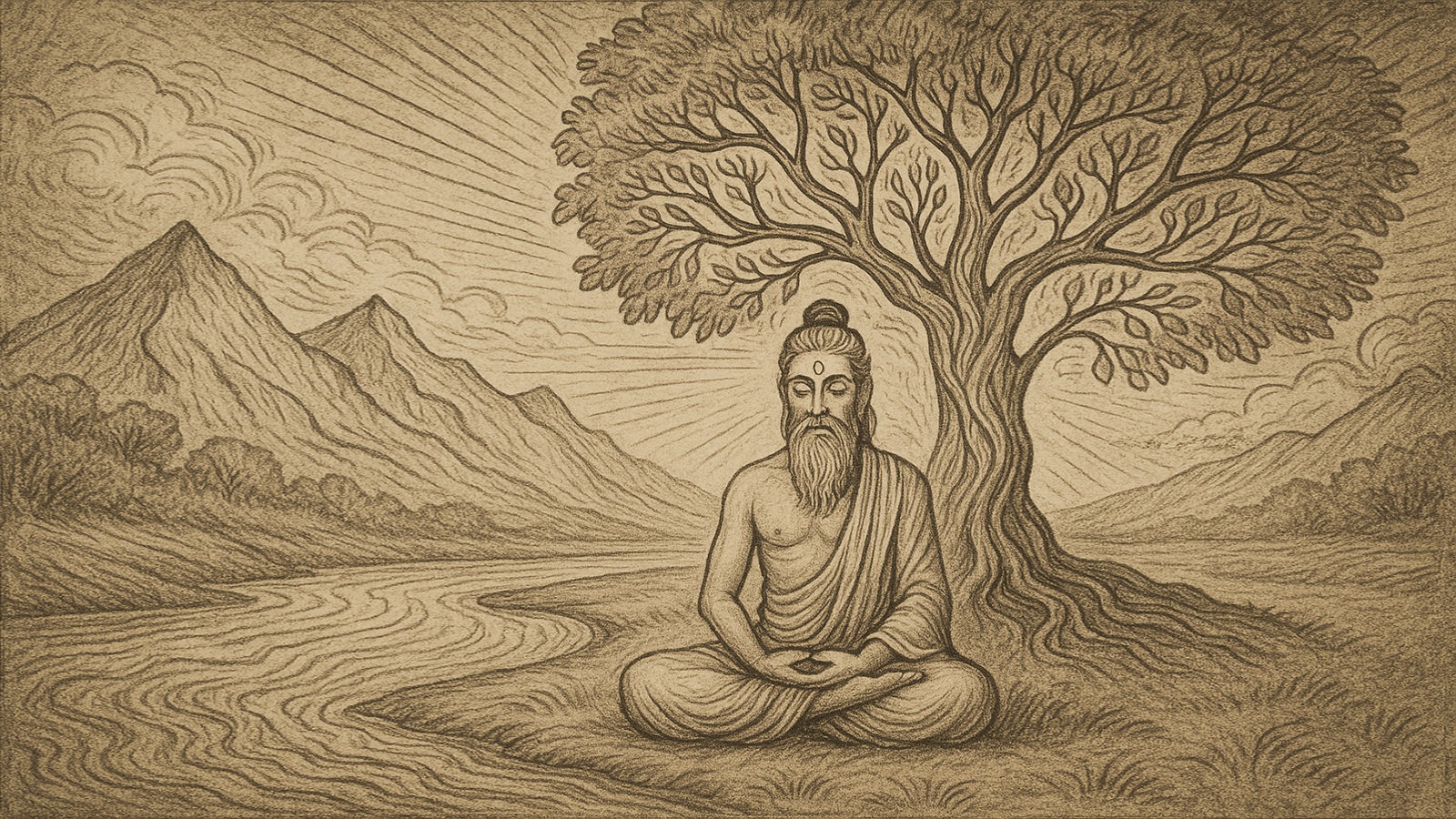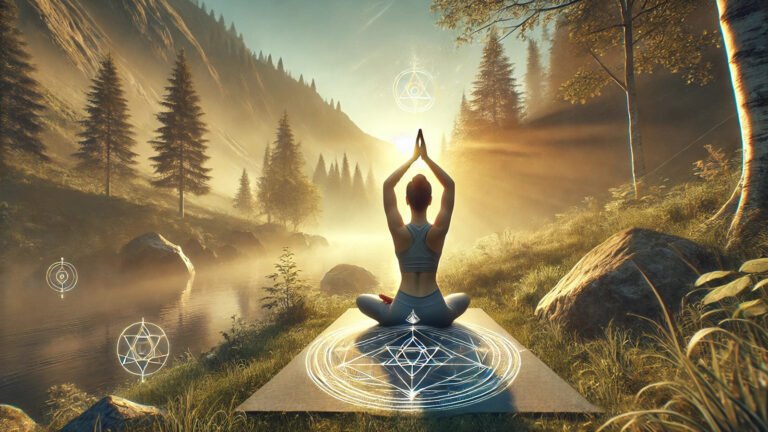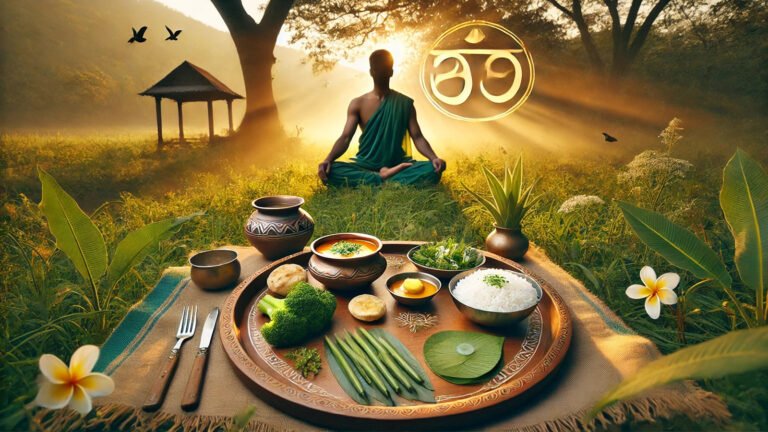Yog, derived from the Sanskrit root word “Yuj” (युज्), meaning “to join,” “to unite,” or “to yoke,” is a profound spiritual discipline rooted in ancient Indian philosophy. The root “Yuj” is found in classical Sanskrit grammar and holds multiple contextual meanings such as yoking (as in attaching oxen to a cart), union, concentration, and integration. From this root, the noun “Yog” (योग) is formed, which refers to the union of the individual self (Atman) with the universal consciousness (Brahman). In broader terms, it implies the harmonious integration of body, mind, and spirit.
Yog is a holistic approach that harmonizes these aspects through a system of physical postures (asans), breath control (pranayam), meditation (dhyan), and ethical practices. Far beyond just physical fitness, Yog serves as a path to inner clarity, emotional stability, and self-realization.
Table Of Contents
- Origin of the Term “Yog”
- What is Yog? – A Timeless Spiritual Science
- Bhagwan Hiranyagarbh – The First Sage of Yog
- Lord Shiva: Adiyogi –The Embodiment of Yog
- Maharshi Patanjali – The Sage Who Systematized Yog
- Bhagwan Lakulish – The Reviver of Yog in Kali Yuga
- Guru Shishya Parampara – The Living Lineage of Yog
- Our Vision – Yog and Pranayam for the Modern Seeker
— Origin of the Term "Yog" —
The term Yog is derived from the Sanskrit root “yuj” (युज्). According to the grammatical treatise of Maharishi Panini, the root “yuj” holds three primary interpretations across different verb groups (dhatu-gan):
-
In the Rudhadi collection, it signifies union or joining (युजिर योगे),
-
In the Divadi collection, it means absorption or Samadhi,
-
And in the Churadi collection, it refers to restraint or control.
Based on the first meaning, Yog implies the union of the individual soul (जीवात्मा) with the Supreme Consciousness (परमात्मा). In the second context, it denotes a state of deep meditative absorption (समाधि), as reflected in Vyas’s commentary on the Yog Sutras, where he defines Yog as Samadhi. The Bhojavritti elaborates this interpretation: “योगो युक्तः समाधिः। युज् समाधौ इति।” (yogo yuktah samadhihi – yuj samadhau iti ), indicating that Yog is synonymous with Samadhi.
The third interpretation, restraint, forms the basis of Maharishi Patanjali’s classical definition: “योगश्चित्तवृत्तिनिरोधः” (Yogaschitta-vriti-nirodhah),
meaning Yog is the cessation or control over the fluctuations of the mind. Thus, all three traditional interpretations of the root “yuj” — union, concentration, and restraint — are intrinsically linked to the concept of Yog.
Moreover, the word Yog is used both as a means and as a goal. As a practice, Yog refers to the disciplined methods through which the state of Samadhi is achieved. As a result, it refers to the ultimate union — the realization of one’s true Self and unity with the Divine. This is emphasized in the Yog Darshan by Patanjali:
“तदादृष्टुः स्वरूपे अवस्थानम्” (Tadadrastuh svarupe avasthanam) —
Then the seer rests in their true nature.
Through sustained yogic discipline, the practitioner transcends sensory distractions and becomes established in the pure Self (Atma), ultimately realizing Brahmatattva — the Supreme Truth. This absolute reality is beyond the constraints of time, space, and the cycle of birth and death. It is non-dual, eternal, unchanging, all knowing, stable, Transcendent, and infinite — the ultimate aim of Yog.
Throughout history, sages and spiritual masters have emphasized that Yog is Sanatan — eternal. It does not belong to any religion or culture, but is a universal science of consciousness. It has been practiced and preserved through thousands of years by enlightened beings who realized its truths not just intellectually, but through direct inner experience. Yog encompasses every aspect of life: physical health, mental clarity, emotional balance, ethical conduct, and spiritual awakening. Its ultimate goal is the realization of the Self, and through that, the realization of God.
True Yog is lived, not merely learned. It is a lifestyle rooted in self-discipline, devotion, and inner purification. From external practices like Asan and Pranayam to deeper internal disciplines like Dharana, Dhyan, and Samadhi, Yog provides a complete framework for evolving human consciousness. Whether one seeks peace, health, wisdom, or liberation, Yog offers a time-tested path to attain it.
— What is Yog? – A Timeless Spiritual Science —
The Vedas of India are widely regarded as the oldest extant texts in the world. They contain profound insights into Brahmavidya—the ultimate spiritual knowledge, defined as the science of realizing the Supreme Brahman. This Brahmavidya is synonymous with Yogvidya, as reflected in the Srimad Bhagavad Gita, where the essence of Yogshastra is extensively elaborated by Lord Krishna.
In fact, every chapter of the Bhagavad Gita is titled with the word “Yog,” signifying its thematic foundation in Yogic wisdom. At the conclusion of each chapter, Maharishi Vedvyas affirms this connection with the declaration:
ॐ तत्सदिति श्रीमद् भगवद् गीतासुपनिषदसु ब्रह्मविद्यायां योगशास्त्रे श्रीकृष्णार्जुनसंवादे… योगो नाम… अध्यायः॥
“Om tatsat—thus concludes the Upanishadic discourse known as the Brahmavidya and the Yogshastra in the dialogue between Shri Krishna and Arjun”
This clearly affirms that Brahmavidya and Yogshastra are not distinct disciplines but are, in essence, one and the same.
According to the scriptures, Brahmatattva—the Supreme Principle—is the ultimate reality, beyond which nothing remains to be known. Realization of this truth leads to liberation (moksh), the release from the cyclical bondage of birth and death. Therefore, Yogvidya is the knowledge that leads to immortality and is considered true knowledge, as emphasized in the scriptural maxim:
“सा विद्या या विमुक्तये।” — “That alone is true knowledge which leads to liberation.”
From this perspective, conventional academic degrees, while valuable for worldly sustenance, are inadequate for spiritual liberation. Such worldly education (avidya) cannot liberate the soul from the repetitive cycle of reincarnation. In contrast, Yog is the true path to salvation. As one of the six classical schools of Indian philosophy (Shad Darshans), Yogshastra represents a time-honored tradition of self-realization.
Yogvidya aims to provide direct experiential knowledge of Brahmatattva. However, theoretical understanding alone is insufficient; true comprehension requires personal realization. Just as scientific hypotheses must be tested through experimentation, the truths of Yog must be verified through disciplined practice. Thus, both scriptural study and practical application are essential for the realization of the Supreme.
In today’s world, where interest in Yog is surging globally, it is natural to inquire into its true essence and the reason for its universal appeal. Maharishi Patanjali, the compiler of the Yog Sutra and founder of Yogdarshan, defines Yog as:
“योगश्चित्तवृत्तिनिरोधः” — “Yog is the control on the fluctuations of the mind.”
When the senses are withdrawn and the mind becomes still, one attains Super Consciousness. In his authoritative commentary, Maharishi Vyas further clarifies this concept by stating:
“योगः समाधिः” — “Yog is Samadhi (deep meditative absorption).”
— Bhagwan Hiranyagarbh – The First Sage of Yog —
According to ancient Vedic tradition, Bhagwan Hiranyagarbh is regarded as the first and most ancient seer of Yog. His name, which translates to “Golden Womb,” symbolizes the divine cosmic source from which the universe was born. Hiranyagarbh is described as the original manifestation of pure consciousness, who received the knowledge of Yog directly from the Supreme Being and transmitted it to the Rishis of the Vedic era.
The Rigveda, one of the oldest sacred texts known to humanity, mentions Hiranyagarbh as the progenitor of all existence and the spiritual intelligence behind the order of creation. He is seen not as a person in the human sense, but as a divine principle — the first embodiment of Yogic wisdom. The scriptures state, “हिरण्यगर्भ योगस्य वक्तानान्यः पुरातनाः”, (Hiranyagarbha Yogasya Vakta Nanyah Puratanah) affirms that Hiranyagarbh is the earliest teacher of Yog; no one precedes him in this sacred knowledge.
The wisdom of Yog that Hiranyagarbh revealed laid the foundation for all future teachings. He not only imparted the practical disciplines of Yog, such as breath control, postures, and meditation, but also the philosophical essence behind them. His teachings emphasized balance, cosmic order, inner purity, and the alignment of human life with divine law. As such, Bhagwan Hiranyagarbh is honored as the Adi Rishi, the primordial sage whose vision continues to illuminate the path of Yog for seekers even today.
Lord Shiva – Adiyogi
— The Embodiment of Yog —
In the Shaivite tradition and yogic cosmology, Lord Shiva is revered as the Adiyogi — the first Yogi, because he is believed to be the first being to attain and transmit the complete knowledge of Yog to humanity. He is the primordial source from whom the science of Yog originated. Unlike Hiranyagarbh, who symbolizes the revealed intelligence of creation, Shiva embodies the transcendental force beyond creation. He is both the supreme ascetic and the divine dancer, representing stillness and dynamism in perfect harmony. Shiva is not merely a mythological figure; in yogic understanding, He is the living symbol of pure consciousness in its meditative and awakened form.
Legend says that thousands of years ago, Shiva sat in profound silence atop Mount Kailash. He was so immersed in blissful meditation that even the gods could not approach him. Yet, seven sages — the Sapta Rishis — waited patiently, recognizing his divine wisdom. After years of silent transmission, Shiva opened his eyes and shared the sacred science of Yog with them. This became the first formal teaching of Yog, and marked the beginning of the Guru–Shishya Parampara.
Shiva’s teachings encompass all aspects of Yog: Asana, Pranayama, Mudra, Bandha, Dhyana, and ultimately, Samadhi. According to ancient yogic scriptures, Shiva is said to have discovered 8.4 million (84 lakh) asanas, representing each form of life in the universe. Out of these, 84 are regarded as most essential, and a few dozen have been preserved through lineage-based practice. These are not merely physical postures but energetic blueprints, designed to awaken specific aspects of consciousness.
He is the source of Tantra, the initiator of Kundalini awakening, and the destroyer of ego and ignorance. The symbolism of his third eye, the damaru (drum), the crescent moon, and the river Ganga flowing from his hair are all allegorical representations of Yogic principles.
As Adiyogi, Shiva is not worshipped merely as a deity but followed as the ultimate teacher of Yog. His presence signifies the boundless possibilities that Yog offers to transcend suffering and realize the infinite within.
Maharshi Patanjali
– The Sage Who Systematized Yog —
While the origins of Yog lie in divine revelation and ancient seers, it was Maharshi Patanjali who gave it a structured, scientific form. He is honored as the great sage who compiled the diverse Yogic knowledge into a coherent framework known as Ashtanga Yog — the Eightfold Path. His work, the Yoga Sutras, consisting of 196 concise aphorisms, stands as the most authoritative text on Yogic philosophy.
Patanjali’s brilliance lies in his clarity. He defined Yog as “Yogah Chitta-Vritti-Nirodhah” — the cessation of mental fluctuations — presenting Yog not merely as physical discipline but as a complete spiritual science. His eightfold path includes Yama, Niyama, Asana, Pranayama, Pratyahara, Dharana, Dhyana, and Samadhi — guiding the practitioner from outer discipline to inner liberation.
Through his systematization, Patanjali transformed Yog into a universally applicable path that continues to inspire seekers across centuries. His teachings remain timeless — bridging the inner and outer worlds with precision, depth, and profound spiritual insight.
Bhagwan Lakulish
— The Reviver of Yog in Kaliyug —
In the sacred lineage of Yogic masters, Bhagwan Lakulish stands as a monumental figure, recognized as the 28th avatar of Lord Shiva. He incarnated in the holy town of Kayavarohan in Gujarat, a place known in scriptures as one of the major Shiva Peeths. Bhagwan Lakulish appeared not to establish a new religion or institution, but to revive the pure and disciplined path of Yog that had faded over time.
Bhagwan Lakulish’s teachings centered around the internal aspects of Yog. He emphasized Kaya Sadhana — the process of transforming the physical body into a vessel of divine energy through austerity, discipline, and Yogic practice. His core message was that spiritual liberation is not attained merely through rituals or intellectual study, but through intense personal effort, inner purification, and unwavering dedication to the Guru.
He strongly advocated for Brahmacharya (celibacy), Tapasya (austerity), and Guru Bhakti (devotion to the master) as essential pillars of true Yogic life. His path was deeply aligned with Ashtanga Yog, especially emphasizing Pranayama, Dhyan, and Samadhi as tools for inner transformation. His life itself became a beacon of silence, stillness, and spiritual intensity.
Though he did not leave behind written scriptures, his teachings lived through his disciples and the Guru–Shishya Parampara that he rekindled. Even today, the spiritual centers following his path uphold his vision of Yog as a sacred science of inner realization and self-mastery.
Guru Shishya Parampara
— The Living Lineage of Yog —
The Guru–Shishya Parampara is the soul of Yogic transmission. Unlike academic learning, Yog cannot be fully grasped through books or lectures; it must be lived, experienced, and awakened through the grace of a realized Guru. This sacred tradition of passing knowledge directly from master to disciple has preserved the purity of Yog for thousands of years.
In the Guru–Shishya Parampara, the Guru is not just a teacher but a living embodiment of Yogic truth. The disciple (Shishya) approaches the Guru with humility, surrender, and a burning desire for liberation. Through close proximity, service, and inner readiness, the disciple receives not only teachings but also energetic transmission (Shaktipat). The Guru awakens the dormant spiritual energy within the seeker and guides them through the challenges of the inner path.
This tradition has ensured that Yog remains a vibrant and living discipline, not just a historical philosophy. In the Lakulish Parampara, this lineage flows through Bhagwan Lakulish to Swami Kripalvanandji to Swami Rajarshi Muni, and others who have preserved and expanded the reach of authentic Yog. Each disciple carries forward not just words, but the living flame of direct experience.
The Guru–Shishya Parampara reminds us that spiritual evolution is not a solo journey. It is a divine collaboration between grace and effort, between the light of the Guru and the readiness of the disciple. Through this lineage, the wisdom of Yog continues to transform lives across generations.
Our Vision
— Yog and Pranayam for the Modern Seeker —
This blog is born from a sacred intention: to share the timeless science of Yog and Pranayam with clarity, depth, and authenticity. While our roots lie in the Lakulish Yog Parampara, our vision is inclusive, aiming to present the universal aspects of Yog that transcend traditions and speak to the heart of every sincere seeker.
In a world filled with distractions, stress, and superficial understanding, we strive to return to the core principles of Yog — discipline, self-awareness, inner peace, and connection to the Divine. Whether you are a beginner exploring Asanas or a dedicated practitioner deepening your Pranayama and meditation, this space offers structured guidance, philosophical context, and spiritual inspiration.
Our commitment is to remain true to the spirit of Yog as a way of life — not merely a set of techniques, but a complete system for human transformation. We honor the teachings of Bhagwan Lakulish and the Guru–Shishya lineage, while also embracing the vastness of Yogic wisdom found across scriptures and traditions.
Through this platform, we invite you to explore the path of Yog and Pranayam, not as a routine or hobby, but as a sacred journey toward the highest expression of your being. May each breath, each posture, and each moment of awareness bring you closer to your true self.



